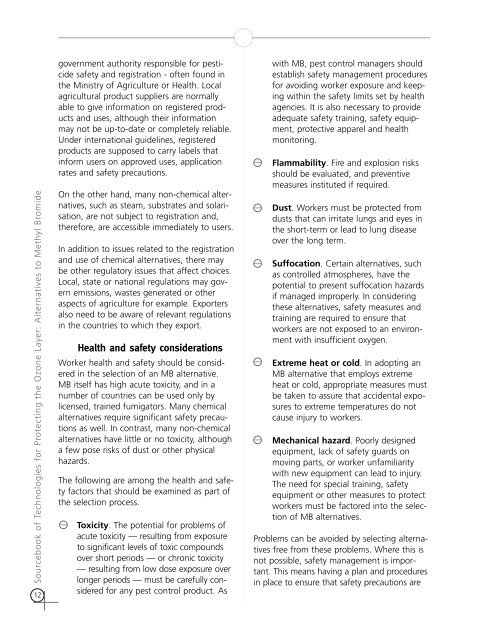Alternatives to Methyl Bromide - DTIE
Alternatives to Methyl Bromide - DTIE
Alternatives to Methyl Bromide - DTIE
Create successful ePaper yourself
Turn your PDF publications into a flip-book with our unique Google optimized e-Paper software.
Sourcebook of Technologies for Protecting the Ozone Layer: <strong>Alternatives</strong> <strong>to</strong> <strong>Methyl</strong> <strong>Bromide</strong><br />
12<br />
government authority responsible for pesticide<br />
safety and registration - often found in<br />
the Ministry of Agriculture or Health. Local<br />
agricultural product suppliers are normally<br />
able <strong>to</strong> give information on registered products<br />
and uses, although their information<br />
may not be up-<strong>to</strong>-date or completely reliable.<br />
Under international guidelines, registered<br />
products are supposed <strong>to</strong> carry labels that<br />
inform users on approved uses, application<br />
rates and safety precautions.<br />
On the other hand, many non-chemical alternatives,<br />
such as steam, substrates and solarisation,<br />
are not subject <strong>to</strong> registration and,<br />
therefore, are accessible immediately <strong>to</strong> users.<br />
In addition <strong>to</strong> issues related <strong>to</strong> the registration<br />
and use of chemical alternatives, there may<br />
be other regula<strong>to</strong>ry issues that affect choices.<br />
Local, state or national regulations may govern<br />
emissions, wastes generated or other<br />
aspects of agriculture for example. Exporters<br />
also need <strong>to</strong> be aware of relevant regulations<br />
in the countries <strong>to</strong> which they export.<br />
Health and safety considerations<br />
Worker health and safety should be considered<br />
in the selection of an MB alternative.<br />
MB itself has high acute <strong>to</strong>xicity, and in a<br />
number of countries can be used only by<br />
licensed, trained fumiga<strong>to</strong>rs. Many chemical<br />
alternatives require significant safety precautions<br />
as well. In contrast, many non-chemical<br />
alternatives have little or no <strong>to</strong>xicity, although<br />
a few pose risks of dust or other physical<br />
hazards.<br />
The following are among the health and safety<br />
fac<strong>to</strong>rs that should be examined as part of<br />
the selection process.<br />
Toxicity. The potential for problems of<br />
acute <strong>to</strong>xicity — resulting from exposure<br />
<strong>to</strong> significant levels of <strong>to</strong>xic compounds<br />
over short periods — or chronic <strong>to</strong>xicity<br />
— resulting from low dose exposure over<br />
longer periods — must be carefully considered<br />
for any pest control product. As<br />
with MB, pest control managers should<br />
establish safety management procedures<br />
for avoiding worker exposure and keeping<br />
within the safety limits set by health<br />
agencies. It is also necessary <strong>to</strong> provide<br />
adequate safety training, safety equipment,<br />
protective apparel and health<br />
moni<strong>to</strong>ring.<br />
Flammability. Fire and explosion risks<br />
should be evaluated, and preventive<br />
measures instituted if required.<br />
Dust. Workers must be protected from<br />
dusts that can irritate lungs and eyes in<br />
the short-term or lead <strong>to</strong> lung disease<br />
over the long term.<br />
Suffocation. Certain alternatives, such<br />
as controlled atmospheres, have the<br />
potential <strong>to</strong> present suffocation hazards<br />
if managed improperly. In considering<br />
these alternatives, safety measures and<br />
training are required <strong>to</strong> ensure that<br />
workers are not exposed <strong>to</strong> an environment<br />
with insufficient oxygen.<br />
Extreme heat or cold. In adopting an<br />
MB alternative that employs extreme<br />
heat or cold, appropriate measures must<br />
be taken <strong>to</strong> assure that accidental exposures<br />
<strong>to</strong> extreme temperatures do not<br />
cause injury <strong>to</strong> workers.<br />
Mechanical hazard. Poorly designed<br />
equipment, lack of safety guards on<br />
moving parts, or worker unfamiliarity<br />
with new equipment can lead <strong>to</strong> injury.<br />
The need for special training, safety<br />
equipment or other measures <strong>to</strong> protect<br />
workers must be fac<strong>to</strong>red in<strong>to</strong> the selection<br />
of MB alternatives.<br />
Problems can be avoided by selecting alternatives<br />
free from these problems. Where this is<br />
not possible, safety management is important.<br />
This means having a plan and procedures<br />
in place <strong>to</strong> ensure that safety precautions are
















